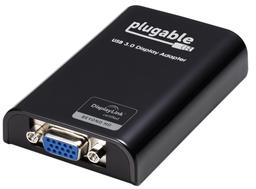Some projectors and TVs won’t display anything when connected to a computer via the USB 3.0 to VGA graphics adapter, however they do display when connected to a computer via the VGA port or a USB 2.0 VGA adapter. What is going on here?

DisplayLink’s USB 3.0 generation products have a different behavior from the USB 2.0 generation — they disable themselves if nothing is attached. HDMI and DVI have a pin for hot-plug detection, but VGA does not. So the only way to know if a monitor is attached with VGA is if the monitor’s display information (EDID) can be read over the VGA cable. But there are cases where EDID information is lost, like with long (+10ft/3m) VGA cables — in these cases, the USB 3.0 VGA adapter will assume there’s no display there.
Background
To understand what is happening we need to take a step back and look at the EDID standard. EDID, or Extended Display Identification Data, is information that is stored on most external displays. The EDID information contains a slew of display specific information like refresh rates, preferred timings, native resolutions, color space, audio capabilities, and other manufacturer details.
Normally, when you connect a 1920 x 1080 monitor directly to your computer, the graphics card tries to communicate with the display to read its EDID. If succeeds, it will learn that the monitor resolution is 1920 x 1080 and will output the proper 1920 x 1080 image. However, if EDID is not present, the graphics card will make a naive decision on what resolution to output to the connected monitor. Instead of getting a 1920 x 1080 image on your large monitor, you can end up with a resolution of 640 x 480 on a 1920 x 1080 display. The key point is that even without an EDID, the computer still outputs an image.
But for the USB 3.0 VGA adapter, having no EDID looks the same as having no monitor attached at all. So when can this happen?
Some TVs do not report EDID. Unfortunately, there is no simple solution to get these TVs to work as an external monitor using the USB 3.0 to VGA adapter. The only workaround is to either use the USB 2.0 to VGA adapter or a direct VGA port on the computer instead of the USB 3.0 to VGA adapter.
While most projectors do report their EDID information, many projector setups have lengthy VGA cables involved (e.g. ceiling projectors). When using a long VGA cable (+10ft/3m) the signal on the line where EDID is being read can get degraded and will not be visible to the USB 3.0 to VGA adapter. The solution around this is to either connect the VGA cable directly into the computer via a native VGA port, use a shorter VGA cable, or to use the USB 2.0 to VGA adapters that might not set an optimal mode without EDID, but will try a default mode at least.

